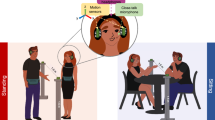Abstract
Persons participating in interview conversations tend to adapt their voice levels, utterance frequency, and pauses with their interaction partners. If individual A participates in dyadic interviews with individuals B, C, D, E, and F, Fourier series analysis of time variant representations of A's utterances tend to be more like those of his dyadic partner than his own utterances in the other conversations. This research points to an objective means where by conversation partners may be identified mechanically without reference to more traditional human understandings of conversation partner identifications.
Similar content being viewed by others
References
Acton, F. S.Numerical methods that work. New York: Harper & Row, 1970.
Akima, H. Algorithm 433, interpolation and smooth curve fitting based on local procedures (E2).Communications of the ACM, 1972,15, 10.
Bales, R. F., Strodtbeck, F. L., Mills, T. M., and Roseborough, M. E. Channels of communication in small group interaction.American Sociological Review, 1951,16, 461–468.
Bernstein, N.The Coordination and Regulation of Movements. New York: Pergamon Press, 1967.
Birdwhistell, R. L.Kinesics and context. Philadelphia: University of Pennsylvania Press, 1970.
Bullowa, M. When infant and adult communicate, how do they synchronize their behaviors? In A. Kendon, R. M. Harris, M. R. Key (Eds.),The organization of behavior in face-to-face interaction. The Hague: Mouton, 1975.
Chapple, E. D.Cultural and biological man, New York: Holt, Rinehart, and Winston, 1970.
Condon, W. S., & Ogston, W. D. A segmentation of behavior.Journal of Psychiatric Research, 1967,5, 221–235.
Condon, W. S., & Sander, L. W. Synchrony demonstrated between movements of the neonate and adult speech.Child Development, 1974,45, 456–462. (a)
Condon, W. S. & Sander, L. W. Neonate movement is synchronized with adult speech: Interactional participation in language acquisition.Science, 1974, January, 183. (b)
Duncan, S. Some signals and rules for speaking turns in conversations.Journal of Personality and Social Psychology, 1972,23,(2), 283–292.
Goldman-Eisler, F. Individual differences between interviewers and their effects on interviewers' conversational behavior.Journal of Mental Science, 1952,98, 660–671.
Goldman-Eisler, F. Sequential temporal patterns and cognitive processes in speech.Language and Speech, 1967,10, 122–132.
Hall, E. T.The hidden dimension. New York: Doubleday, 1969.
Hall, E. T.The silent language. New York: Doubleday, 1973.
Hall, E. T.Beyond culture, New York: Doubleday, 1976.
Hamming, R. W.Numerical methods for scientists and engineers. New York: McGraw-Hill,1962.
Hewlett-Packard.9820A Math Pac. Palo Alto, California: Hewlett-Packard Company.
Jaffe, J., & Feldstein, S.,Rhythms of dialogue. New York: Academic Press, 1970.
Jefferson, G. Side sequences. In D. Sudnow, (Ed.),Studies in social interaction. New York: Free Press, 1972.
Lashley, K. S. The problem of serial order in behavior. In L. S. Jeffress (Ed.),Cerebral mechanisms in behavior. New York: Wiley, 1951.
Matarazzo, J. D., and Wiens, A. H. Interviewer influence on durations of interviewee silence. Journal of Experimental Research in Personality, 1967,2, 56–59.
Matarazzo, J. D., Wiens, A. N., & Saslow, G. Studies in interview speech behavior. In L. Krasner & P. Ullman (Eds.),Research in behavior modification: New developments and implications. New York: Holt, Rinehart, and Winston, 1965.
Scheflen, A. E. Stream and structures of communicative behavior (Behavioral Studies Monograph 50). Philadelphia: Eastern Pennsylvania Psychiatric Insitute, 1965.
Scheflen, A. E.Body language and the social order. Englewood Cliffs, New Jersey: Prentice-Hall, 1972.
Schutz, A.Collected Papers II. Studies in Social Theory. The Hague: Martinus Wijhoff, 1971.
Sudnow, D. (Ed.).Studies in social interaction. New York: Free Press, 1972.
Warner, R. M. Periodic rhythms in conversational speech,Language and Speech, 1979,22, 4.
Wolff, P. H. The role of biological rhythms in early psychological development.Bulletin of the Menninger Clinic, 1967,31, 197–218.
Author information
Authors and Affiliations
Rights and permissions
About this article
Cite this article
Gregory, S.W., Hoyt, B.R. Conversation partner mutual adaptation as demonstrated by Fourier series analysis. J Psycholinguist Res 11, 35–46 (1982). https://doi.org/10.1007/BF01067500
Accepted:
Issue Date:
DOI: https://doi.org/10.1007/BF01067500




